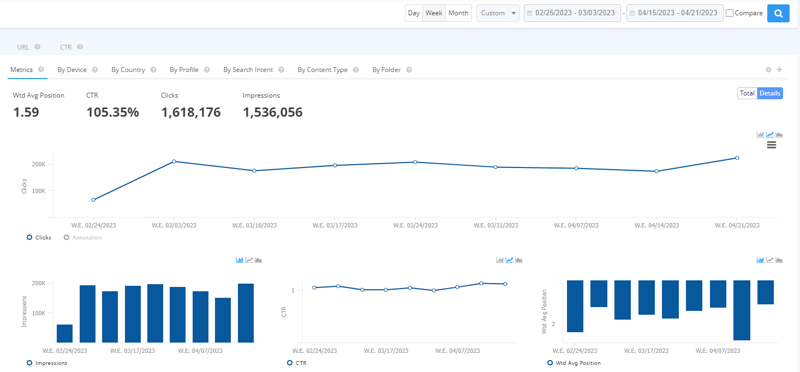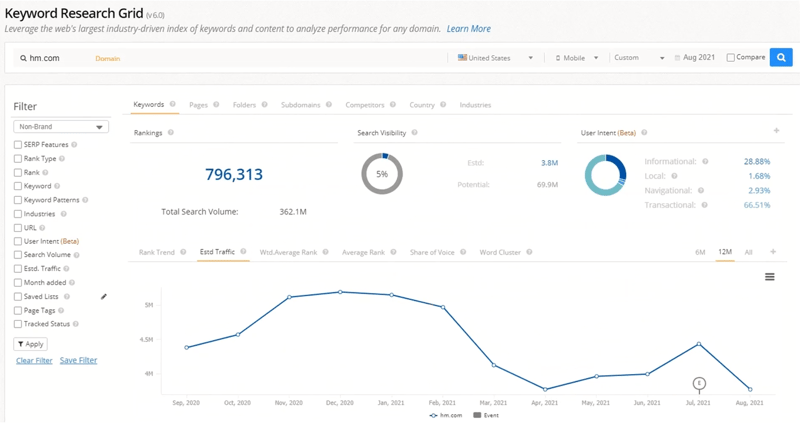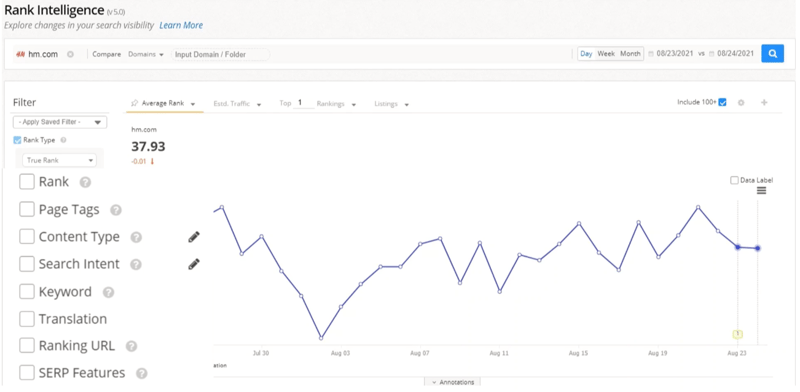When referencing different SEO datasets, it’s important to make sure everyone understands what they’re looking at and why it matters — from experienced SEOs to stakeholders, product teams, executives, and ecommerce teams.
An all-in-one SEO platform serves as an organization's single source of truth to analyze various SEO performance metrics. To keep it simple, I like to explain SEO performance data as a funnel.
Understanding SEO Performance Data At a Glance
A comprehensive SEO performance dashboard provides a holistic view of the various SEO datasets. These datasets include:
Search Analytics Data:
|
Insights into your site’s keyword and page performance with metrics such as clicks, average position, impressions, and click-through rate. |
Site Analytics Data:
|
Page-level insights on organic search performance over time of the pages that drive traffic to your site. View key metrics such as bounces, session duration, pageviews, time on page, conversions, etc. |
Overall Domain Ranking Data:Sourced from seoClarity’s Research Grid |
A high-level view of your site's (or competitor's site) ranking performance over time using seoClarity's own proprietary dataset. Segmented by keywords, domain, pages, subdomain, and folders. |
Ranking Performance:Sourced from seoClarity’s Rank Intelligence |
Rankings for your most valuable tracked keywords that you manage and track. Leveraging metrics such as average rank, weighted average rank, estimated traffic, share of voice, and more. |
Each stage of the SEO performance funnel
(Combine these different data sources to tell the full story of your SEO performance. This explains how to interpret and utilize the insights from each dataset.)
Click on each stage of the funnel for a more in-depth look at why it's important and how it works in the platform!
Search Data: Insight Into Your Site's Most Engaging Keywords and Pages
Search data provides insights into your site’s keyword performance to determine which keywords drive the most impressions and clicks to your site. This information is sourced from Google Search Console which integrates seamlessly with seoClarity’s Search Analytics.
Why search data is important: Determining which keywords and pages engage users the most provides critical insight into whether your page is relevant to what the user is looking for. It allows you to identify growth opportunities on pages with high impressions and low clicks and discover specific folders or sections of the site that drive clicks or have declined in performance.
How it works in the platform: Search Analytics pulls information directly from Google Search Console and breaks it down into important data points such as impressions, clicks, average position, and click-through rate (CTR).

Achieve substantial insights such as:
- Which keywords drive the most clicks to your site
- Opportunities for optimization (revealed by pages that have a lot of impressions but low clicks)
- Search performance based on search intent and content types
Site Analytics Data: Insights Into User Behavior on Your Site
View site analytics data to determine which pages on your site drive organic traffic. Metrics such as bounce rate also reveal if the content on the page is relevant to the user's search query.
This data is gathered through Google Analytics or another site analytics tool, such as Adobe Analytics. By bringing conversion goals into the platform, it reveals which pages those conversion metrics are attributed to.
Why site analytics data is important: Gaining data and insights on how searchers interact with your web pages helps uncover opportunities to improve your landing pages and gain a deeper understanding of the value specific pages bring in driving traffic to your site.
How it works in the platform: Integrate your site analytics into seoClarity in a few quick steps and bring in historical data to compare traffic performance over time. seoClarity now supports GA4.
.png?width=800&height=250&name=Screenshot%2027-04-2023%20at%2009.11%20(1).png)
Using Site Analytics, it generates important insights by:
- Comparing year-over-year organic traffic performance.
- Analyze the data by dimensions such as country, search engine, device, or page intent to determine areas for improvement.
- See which areas of your site drive the most traffic using Content Types or by viewing the Folder hierarchy.
Overall Domain Ranking SEO Data: Monthly Site Rankings, Research Insights, and Competitor Site Performance
Research Grid allows you to see overall ranking performance for whichever domain you would like to conduct research on, whether it's your own domain or that of your competitors.
Why competitor data is important: By obtaining a comprehensive overview of your website and your competitors' ranking performance, you identify areas of improvement, content gaps, and opportunities. This information enables you to optimize your website and create high-performing content.
How it works in the platform: seoClarity’s 500 million proprietary keyword data set, Research Grid, provides a high-level view of ranking performance on your own site or competitor sites.

It displays ranking keywords and the pages ranking for those keywords. This data is also sorted by subdomains, folders, industries, competitors, the countries they ranked in, and more.
Recommended Reading: 4 Practical Applications of the Research Grid
It generates important insights by:
- Identifying true online competitor domains and uncovering which keywords they rank for
- Building a keyword portfolio
- Finding topic opportunities for industry-specific keywords
- Conducting keyword research to identify content opportunities
Watch Research Grid in action!
Managed Ranking Data: Keyword and Page Ranking Performance
Ranking data provides information on your page's position in the search engine results pages for different keywords.
Why managed ranking data is important: Managed keywords are a prioritized set of important keywords for your SEO strategy. They include top ranking keywords and ones you aim to rank for. These highly relevant keywords are regularly monitored through rank checks. Analyzing their performance provides valuable insights into your SEO strategy's effectiveness.
Tracking ranking data also determines the impact of SEO optimizations to understand which tactics were effective.
How it works in the platform: Rank Intelligence showcases a subset of all the keywords you rank for based on the ones that you chose to prioritize and track the performance of.
Add these keywords through the universal add button, assign keywords to keyword tags to monitor the performance of a group of keywords, and even associate keywords with preferred landing pages to identify when pages you don't want to prioritize for a specific keyword rank higher than your desired page.

View performance by keyword, page, keyword tags, content types, search intent, subdomain, top competitors, and more.
This information helps determine when and where rank changes occur. Monitor progress over time to uncover the cause and resolve any errors.
Recommended Reading: How to Unlock Insights From Your Most Powerful Metric: Rank Position
Conclusion
Clear communication and understanding of SEO datasets are crucial for all parties involved in an organization. Utilizing a reliable SEO platform as a single source of truth simplifies the interpretation and utilization of SEO performance data.
By visualizing SEO performance as a funnel, stakeholders, merchandising managers, and experienced SEOs all gain valuable insights through the use of various data sources to make informed decisions and improve SEO performance.







Comments
Currently, there are no comments. Be the first to post one!